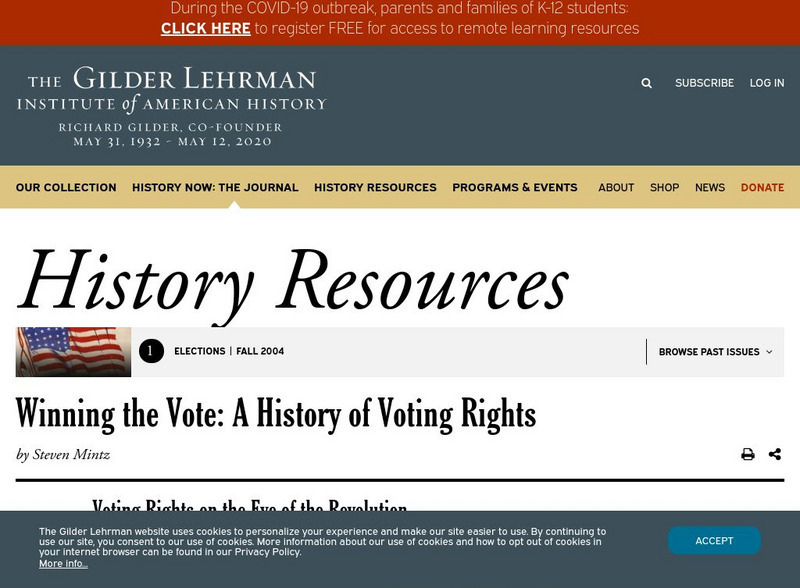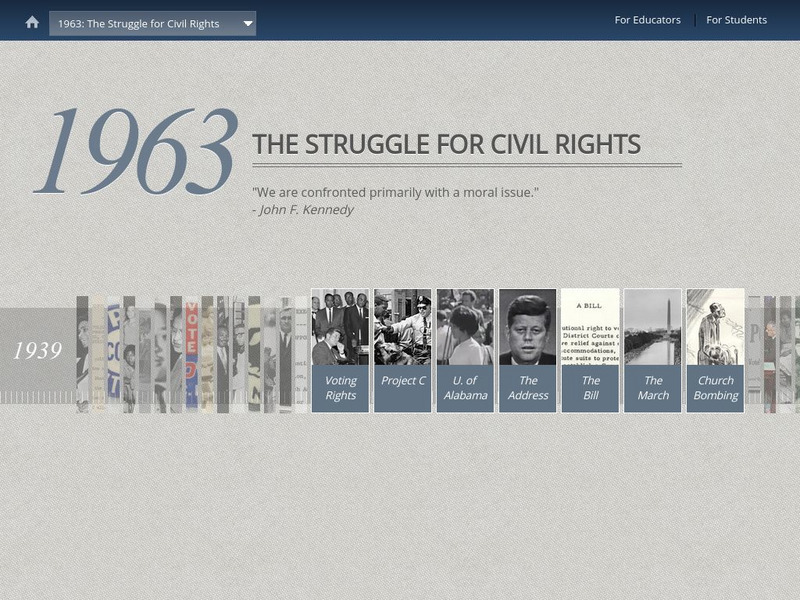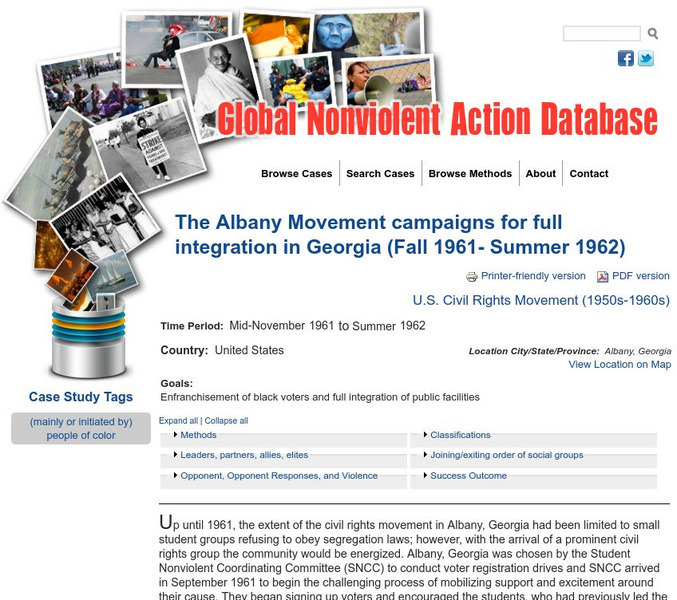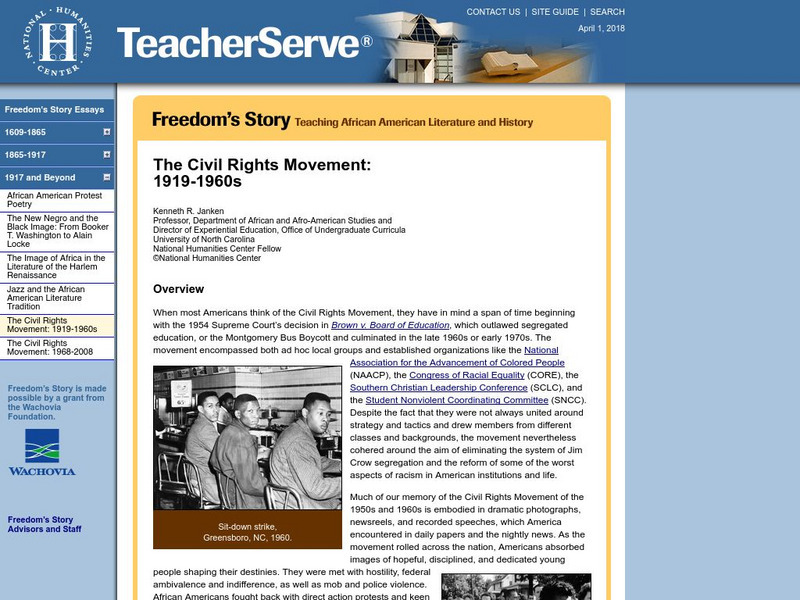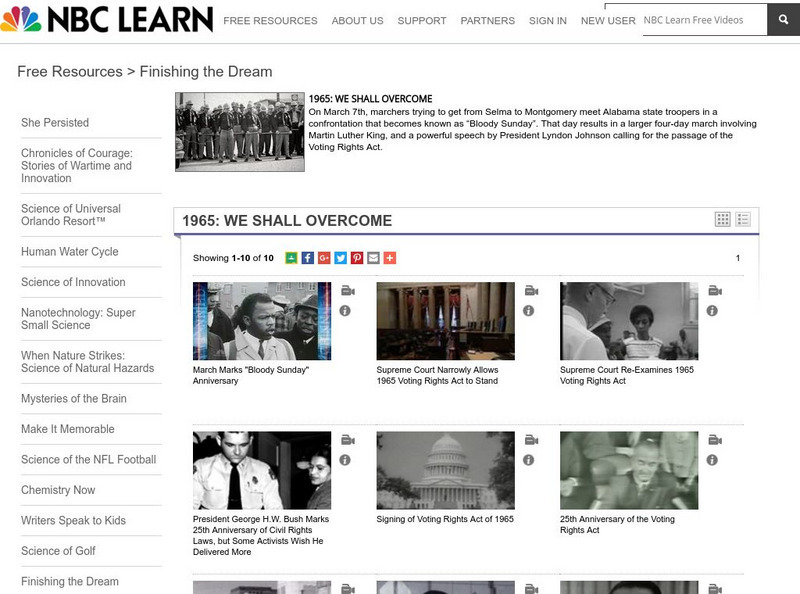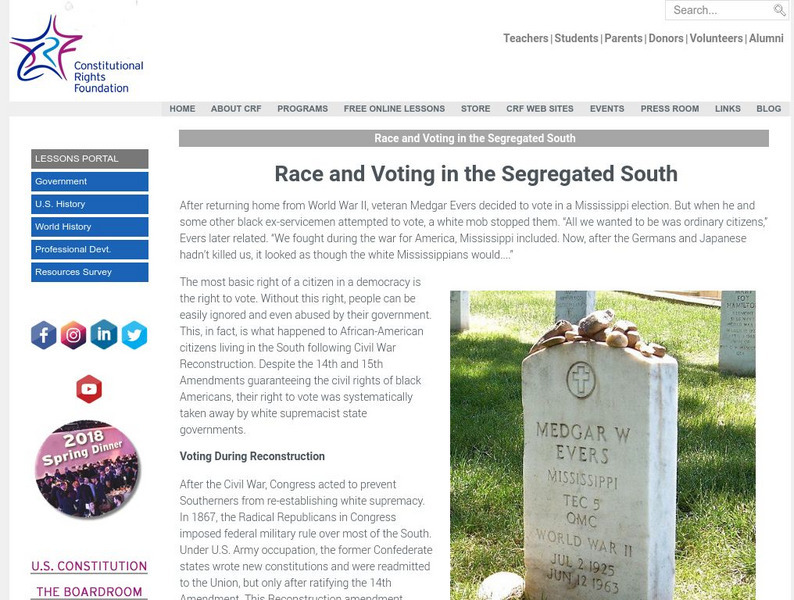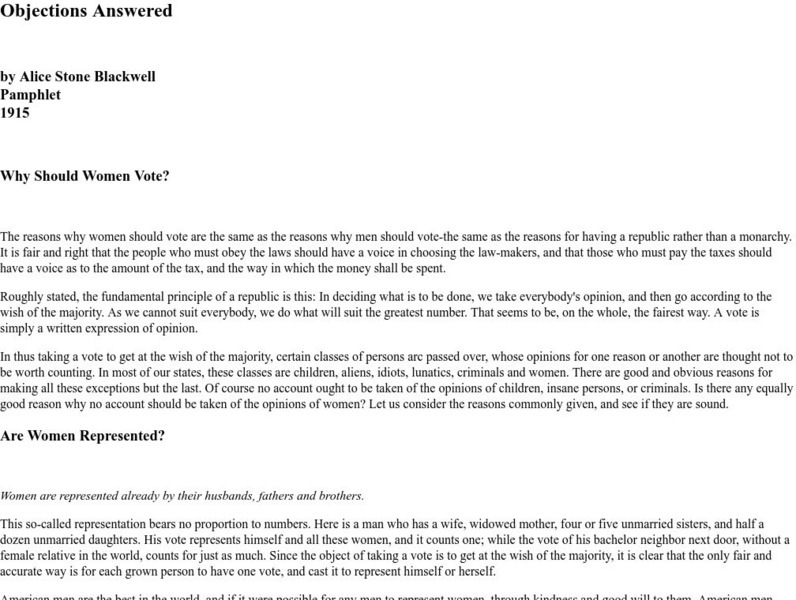Gilder Lehrman Institute of American History
Gilder Lehrman Institute: History Now: Historian's Perspective: Winning the Vote: History of Voting Rights
[Free Registration/Login Required] Historian-authored three-part overview looks at the history of voting rights in America, touching on all the critical moments in American history when voting rights were first denied then granted to...
CommonLit
Common Lit: Text Sets: The Civil Rights Movement
This is a collection of 34 Grade-Leveled texts (4-12)on the topic The Civil Rights Movement. The Civil Rights Movement emerged after nearly a century of little progress for African Americans following the end of slavery. Explore the...
Gilder Lehrman Institute of American History
Gilder Lehrman Institute: The Civil Rights Movement: Major Events and Legacies
[Free Registration/Login Required] An essay that speaks of the major events and legacies of the Civil Rights Movement.
Country Studies US
Country Studies: The Civil Rights Movement 1960 1980
Brief, yet comprehensive, summary of the Civil Rights movement from 1960 until 1980. Includes civil rights policies of presidents Kennedy through Nixon.
National Endowment for the Humanities
Neh: Edsit Ement: Voting Rights for Women: Pro and Anti Suffrage
In this lesson plan, students will consider "Voting Rights for Women: Pro- and Anti-Suffrage." The plan includes worksheets and other student materials that can be found under the resource tab.
iCivics
I Civics: Civil Rights
Use this library of mini-lessons to teach students about the early days of the expansion of slavery in the United States through the momentous 1950s and 60s and into the modern Civil Rights Movement.
Khan Academy
Khan Academy: The Civil Rights Act of 1964 and the Voting Rights Act of 1965
Read about the Civil Rights Act of 1964 and the Voting Rights Act of 1965 which sought to make discrimination illegal, and the resistance they faced from the public and government officials. As time passed, African Americans began to...
Digital Public Library of America
Dpla: Voting Rights Act of 1965
This collection uses primary sources to explore the Voting Rights Act of 1965. Set includes an overview, primary sources, links to related resources, and a teaching guide.
John F. Kennedy Presidential Library & Museum
John F. Kennedy Presidential Library and Museum: The Struggle for Civil Rights
Although his presidency was cut short, JFK had an immense impact on the Civil Rights Movement. Use this interactive timeline to delve into the equality issues plaguing out nation and how Kennedy addressed these concerns. By clicking on...
Other
Global Nonviolent Action Database: The Albany Movement
Learn comprehensive details about the Albany Movement which was characterized by major campaigns of civil resistance and its goal which was the enfranchisement of the black voter and full integration of all public facilities. Although...
National Humanities Center
National Humanities Center: Teacher Serve: The Civil Rights Movement: 1919 1960s
Article provides an overview of the Civil Rights Movement in America between 1919 and the 1960s with detailed discussion on racial equality, nonviolence and passive resistance, and segregation.
NBC
Nbc Learn: Finishing the Dream: 1965: We Shall Overcome
A collection of archival video clips highlighting a peaceful protest in Alabama in 1965 that ended in a confrontation with state troopers known as "Bloody Sunday." This was followed by a four-day march with Martin Luther King, Jr., and a...
Curated OER
History Matters: "And We Shall Overcome": Johnson's Special Message to Congress
Read President Lyndon B. Johnson's speech before the the Congress in support of the Voting Rights Act. Feel the passion in his address and his desire to further racial equality.
Library of Congress
Loc: African American Odyssey: The Civil Rights Era
This two-part feature on African American history offers an in-depth look at the events of the 1960's civil rights movement. Discusses voting rights, laws, military segregation, freedom rides, sit-ins and the NAACP. Includes historic...
Gilder Lehrman Institute of American History
Gilder Lehrman Institute: History Resources: Robert Kennedy on Civil Rights
[Free Registration/Login Required] After reading the background information about Attorney General Robert Kennedy's report on civil rights enforcement activities of the Department of Justice in 1962, read the full transcript of the...
Khan Academy
Khan Academy: Us History: 1945 1980:civil Rights Act 1964/voting Rights Act 1965
Learn about the civil rights legislation that outlawed discrimination in jobs, education, housing, public accommodations, and voting.
US House of Representatives
History, Art, and Archives: The Civil Rights Act of 1957
Read about the role of President Eisenhower in the impetus for the support of civil rights in 1957.
Library of Congress
Loc: Votes for Women: Suffrage Pictures 1850 1920
This extensive and varied resource shares images of the women's suffrage movement in the United States. Conduct a keyword search to explore the collection.
Ducksters
Ducksters: Civil Rights for Kids: Disability Rights Movement
Kids learn about the history of the Disability Rights Movement including the Architectural Barriers Act, the Americans with Disabilities Act, and famous disabled people on this site.
Ducksters
Ducksters: Civil Rights for Kids: African American Civil Rights Movement
Kids learn about the history of the African-American Civil Rights Movement including segregation, Jim Crow laws, protests, Martin Luther King, and the passage of the Civil Rights Act on this site.
ClassFlow
Class Flow: Civil Rights Movement
[Free Registration/Login Required] Through this lesson, students identify individual, personal, and political rights (freedom of religion, freedom of speech, right to own property) by analyzing lives of historical African American...
Scholastic
Scholastic: A Brief History of Women's Rights Movements
Find a history of the several movements that advocated for women's rights in voting, politics, and at work.
Constitutional Rights Foundation
Constitutional Rights Foundation: Race and Voting in the Segregated South
Article and activity in which students read and analyze the historic challenges faced by African Americans as they sought to gain an unimpeded right to vote in the segregated South followed by activity asking students to evaluate current...
Other
D Archives: Alice Stone Blackwell, Objections Answered
Read this 1915 essay by Alice Stone Blackwell, who outlines the basic reasons women should be granted equal voting rights in the U.S.
